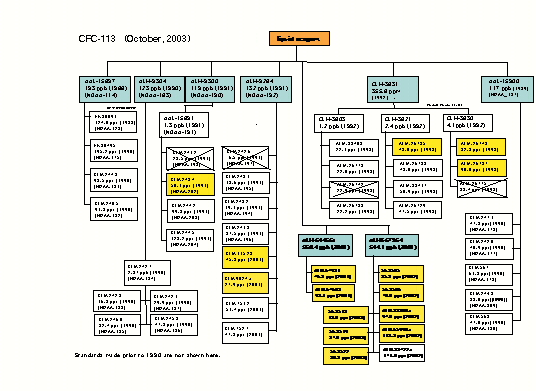CFC-113 Scale
| CFC-113 calibration standards | 2002 Scale | ||||
| updated: April, 2002 | |||||
| year | prepared | assigned | residual | ||
| (ppt) | (ppt) | ||||
| ALM-26735 | 1993 | 48.0 | 48.0 | 0.0 | |
| ALM-26743 | 1993 | 82.8 | 83.6 | 0.8 | |
| ALM-26737 | 1993 | 90.0 | 88.3 | -1.7 | |
| CLM-2434 | 1991 | 50.1 | 51.4 | 1.3 | |
| CLM-11528 | 2001 | 45.8 | 45.8 | 0.0 | |
| CLM-9024A | 2001 | 27.9 | 29.2 | 1.2 | |
| ALM-33800A | 2002 | 95.0 | 95.5 | 0.5 | |
| ALM-65990A | 2002 | 113.9 | 113.9 | 0.0 | |
| ALM-64981A | 2002 | 46.3 | 45.6 | -0.6 | |
| ALM-64608B | 2002 | 93.1 | 93.8 | 0.7 | |
| std dev | 0.91 | ||||
Note: New primary standards prepared in 2003 are not shown here. We are having trouble comparing humidified standards in Essex cylinders to dry standards in Aculife-treated alumimum cylinders. The drying agent Mg(ClO4)2 appears to affect the response of CFC-113 on ECD, but not on GC-MSD. Even with the uncertainties caused by thedrying agent, the 2002 and 1992 scales are equivalent at ambient CFC-113 mixing ratios.

